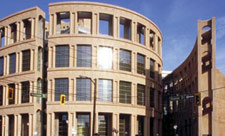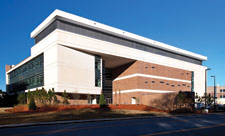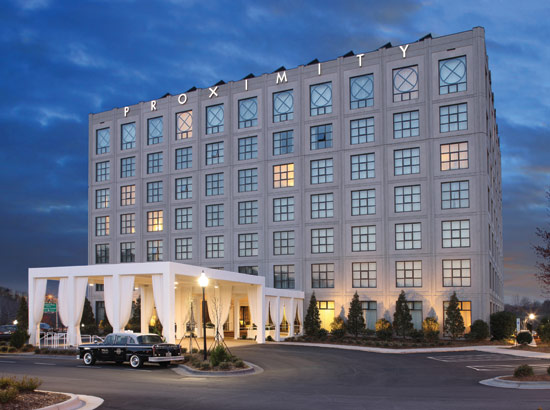Precast Concrete for High Performance Building Envelopes
This versatile, efficient, resilient option meets increasingly stringent building goals
![]() Continuing Education
Continuing Education
Use the following learning objectives to focus your study while reading this month’s Continuing Education article.
Learning Objectives - After reading this article, you will be able to:
- Explain how sustainability is one of a number of components that comprise high performance design
- Discuss the attributes of precast concrete that contribute to a high performance building
- Define the high performance building envelope strategies that utilize precast concrete
- Describe the aesthetic options available with precast concrete envelope systems.
Sustainable. Energy efficient. Durable. For decades, these have been worthy goals for construction materials and systems. Yet as the environmental movement has evolved, these goals become ever more ambitious. Today these attributes—and others—are subsumed in a more all-encompassing term: high performance. The goal of high performance is to design and build structures that optimize all relevant high-performance attributes on a life-cycle basis rather than a solely first-cost basis.
Essential in meeting project goals from environmental to aesthetic to economic, high-performance buildings are being increasingly required by owners and by legislation. Critical to a high-performance building is a high-performance building envelope, that is, an envelope that provides versatility, efficiency, and resiliency. Precast concrete envelope systems inherently offer these attributes, and can be designed to provide many others. This article will provide an overview of what high performance is, and how high-performance precast concrete can help architects meet high-performance goals.
A High-Performance Structure—What Is It?
According to the United States Government in the Energy Independence and Security Act of 2007 - 401 PL 110-140, a high-performance structure is one that “…integrates and optimizes on a life-cycle basis all major high-performance attributes including energy and water conservation, environmental, safety, security, durability, accessibility, cost benefit, productivity, sustainability, functionality, and operational considerations.”
 |
Precast concrete creates an aesthetic, highperformance envelope for today’s structures. Photo by Sandy Cohn, AIA, courtesy of RLF Architects & Engineers |
At the heart of this definition is a fundamental shift in perspective from sustainable design and construction to sustainability and performance on a life-cycle basis. The concept of high-performance encompasses the concepts and practices of sustainability. However, it goes beyond a piecemeal approach by requiring optimization of all relevant attributes for a project. Characteristics such as energy and water conservation, safety, security, and durability are no longer just options, but requirements that must be integrated into a structure's overall design, construction, and performance.
High-performance structures are essential to meeting a variety of demands, and accordingly, green codes and standards, funding entities, and owners are requiring them. Examples include the new International Green Construction Code, LEED (v.4), ASHRAE 189.1, and the mandate by the U.S. Federal Government Executive Order 13514 which requires government buildings to achieve net zero by 2030.
Integral to high-performance structures are high-performance materials and systems—integrated systems that allow for design versatility and are efficient, resilient, and can be optimized to meet the multi-hazard requirements and long-term demands of high-performance structures. Industry watchers maintain that precast concrete is used more and more to help projects meet and exceed their high-performance goals throughout design, construction, and operation.
Precast Concrete Explained
Concrete is a mixture of aggregates (typically sand and stone) that are bound together by a binder. Admixtures or modifying agents and additives are sometimes introduced to improve the characteristics of the fresh concrete, the mixing process, and/or the final hardened material. Precast concrete consists of concrete that is cast into specific shapes at a location other than its final in-service position. It is produced by casting high-strength concrete in a reusable mold or form, which is then cured in a controlled environment at a specially equipped plant.
Precast concrete components are reinforced with either conventional reinforcing steel, steel strands with high tensile strength, or a combination of both. Prestressing is a method of reinforcing where steel strands are pretensioned in the form before the concrete is cast. Once the concrete has cured to a specific strength, the strands are cut, or detensioned. Having bonded to the concrete, the strands attempt to regain their original untensioned length, adding tensile capacity to the precast member that complements concrete's natural strength at resisting compressive forces. This “precompression” increases the load-carrying capacity to the components and helps control cracking to specified limits allowed by the building code.
As a fabricated material, precast concrete continues to evolve as new designs require new solutions and members of the design team push the boundaries of what can be achieved. New admixtures, concrete mixes, fabrication techniques, formliners, and other innovations continue to change and expand the applications of the material and its benefits. In recent years, new capabilities have been added to enhance the uses of the medium, including ultra-high-performance concrete, which provides a compressive strength as high as 30,000 psi.
| High-Performance Precast Envelope System | ||||
Precast concrete is a high-performance material that integrates easily with other systems and inherently provides that versatility, efficiency, and resiliency needed to meet the multi-hazard requirements and long-term demands of high-performance structures.
|
Precast Walls
Precast concrete envelope systems can be used in all types of projects from residential to commercial, to institutional and industrial. They can also be used in everything from low-rise to high-rise construction. Precast concrete wall panels are versatile components that can be used as architectural, structural, or combination elements within a building's design. Wall panels can be designed as loadbearing or non-loadbearing components, and can be used in a number of different structural configurations designed to provide moment and lateral force resistance. Non-loadbearing panels can be attached to any type of structural frame, including precast concrete, cast-in-place concrete, or steel. They can be designed and erected in a horizontal or vertical position.
There are three basic wall types, all of which can be made in essentially any shape, including: window walls, which include “closed” or four-sided fenestration openings; spandrels, which are common for parking structures and ribbon window designs; or column covers, mullions, and other customized shapes.
• Solid. Solid precast concrete walls contain no integral insulation, with walls being typically 4 to 8 inches thick. These traditional wall systems require an interior finish wall system with insulation to complete the envelope.
• Thin shell. This is a newer concept, with walls made by attaching as little as 1.5 inches of concrete to a back-up frame which, though typically comprised of metal studs, can also be produced in concrete. The two are then joined by thermally resistant connectors. The designer can specify a layer of insulation between the exterior concrete wythe and the back-up frame. The back-up frame system allows for drywall to be attached to provide the interior finish. Glass fiber-reinforced concrete (GFRC) precast concrete panels (typically about 1 inch thick of concrete) are another option in which a mix of concrete and glass fibers is sprayed into a mold. GFRC panels are another example of thin-shell systems, which are often used to produce intricate shapes. Thin shell systems allow for lighter weight and help reduce the size of foundations.
• Insulated sandwich wall panels. Typically including 2 inches or more of rigid insulation between two wythes of concrete, insulated sandwich wall panels provide high energy efficiency, meeting the continuous insulation requirements of ASHRAE 90.1, as well as an interior concrete wall that can be painted and used as the interior finished surface, avoiding the need for furring strips and drywall. Precast concrete's high thermal mass also minimizes energy consumption naturally. Historically favored for industrial buildings such as distribution centers and warehouses, sandwich wall panels allow a range of finishes and benefits that has expanded the component's applications to schools, offices, retail, residential, and other uses.
 |
|
Image by PCI |
High-Performance Attributes
Precast concrete integrates easily with other systems and inherently provides the versatility, efficiency, and resiliency needed to meet the multi-hazard requirements and long-term demands of high-performance structures.
Material Versatility
A high-performance material provides versatility in design and construction, and optimizes aesthetic, structural, and use considerations.
• Aesthetic versatility. In terms of aesthetics, precast concrete provides an almost endless array of colors and textures and allows for subtle variations through different techniques such as varying aggregate and matrix colors, size of aggregates, finishing processes, and depth of exposure. The designer can add pigment to the concrete and provide several tones within one panel by using various surface finishes. The ability to combine multiple finishes within one panel reduces detailing, joints, flashing and maintenance costs, as well as the associated liability risks frequently associated with a combination of traditional materials used in cavity wall construction.
 |
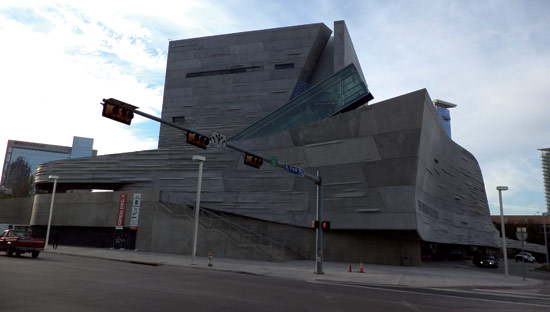 |
The Perot Museum in Texas shows the aesthetic versatility of precast concrete. Photos by Gate Precast Company |
Because of precast's initial plasticity, it may be economically designed with a combination of concave, convex, and flat sectional shapes that are difficult, if not impossible, to achieve with other materials. The medium's plasticity further enables it to interface smoothly with glass and other modern materials, and it can also be embedded, veneered, or sculpted to resemble a wide range of finish materials, including limestone and brick, ensuring that the building blends with nearby structures, whether contemporary or historic. Through the use of formliners, designers can affordably create supergraphics, custom aesthetic treatments, or realistic stone appearances.
• Structural versatility. Precast concrete can serve as structural and cladding/envelope system simultaneously, minimizing material use and accelerating construction. Precast concrete also provides for longer open spans with fewer columns and obstructions, as well as smaller structural cross sections through the use of high-strength concrete and prestressing. Precast hollow-core slabs and double tees, in particular, provide long, clear spans, opening interior spaces in projects from office buildings to parking structures in order to allow designers to maximize leasable or usable space within the building footprint. Loadbearing precast concrete wall panels can reach heights of 55 feet, while double tees can span 80 feet or more. The result of precast's structural versatility is more efficient and less costly construction. The cost savings are greatest for low- to mid-rise structures of three to 10 stories with a large ratio of wall-to-floor area, allowing the owner the ability to more easily adapt floor plans as building functions change.
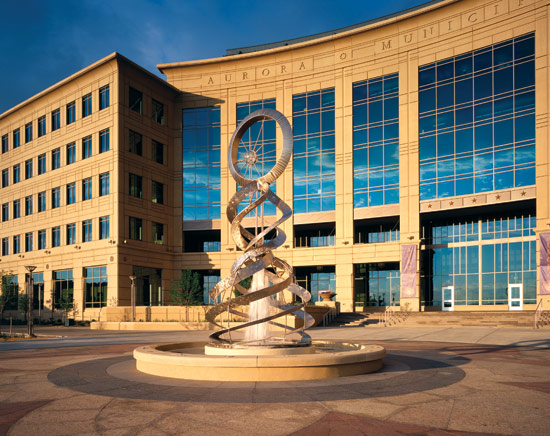 |
Colorado’s Aurora Municipal Building combines open space with a 286,000-square-foot building and a 241,000-square-foot parking structure. Both projects feature total-precast concrete structural systems, which combined architectural and structural components into single units. Photo by Michael Peck |
• Use versatility. Precast concrete both uses recyclable material, and is recyclable itself. Several common industrial byproducts, including fly ash, slag, and silica fume, which would otherwise go to landfills, can be incorporated into concrete as supplementary materials, reducing the necessary amount of cement. Formwork and finishing materials used in fabrication can be reused, with wood or fiberglass forms generally reused 40 to 50 times without major maintenance, and concrete and steel forms having virtually unlimited service lives.
| LEED Platinum Hotel Gains Energy Savings with Precast Concrete Wall Panels | ||
Designed by Centrepoint Architecture, Raleigh, North Carolina, to resemble an old cut-and-sew textile factory, the Proximity Hotel, a AAA 4-Diamond hotel, is the first hotel in the nation to achieve LEED Platinum certification. Featuring over 70 energy and health-related enhancements and earning 55 out of a possible 69 credits for LEED – New Construction, the hotel utilized high-performance, insulated, structurally composite precast concrete wall panels that are durable, impervious, and thermally efficient. The mass wall system includes 3.5 inches of continuous foam insulation at the core that exceeds ASHRAE energy standards, surrounded by exterior and interior precast concrete layers totaling 6.5 inches of concrete. Use of non-conductive wythe connectors virtually eliminated thermal bridging issues. The total material R-value of the wall panels is 15.5, with the panels contributing to a nearly 40 percent energy savings for the total structure, thus allowing the designers to downsize the capacity of the mechanical heating and cooling system for reduced first-cost and life-cycle savings.
|
Precast concrete members are unique in that they are individually engineered products that can be detached and relocated, facilitating future additions to buildings. When future additions occur, non-loadbearing panels on the end simply are disconnected from the framing, and new panels and framing are added on each side. With the new addition in place, the original end panels can be replaced.
When ultimately removed from service, precast concrete members may be reused in other applications. Because it comes apart with a minimum amount of energy and retains its original qualities, precast concrete is also friendly to downcycling, a process in which building materials are broken down. Concrete pieces from demolished structures, for example, can be reused to protect shorelines, and recycled concrete is frequently crushed and used as fill or road base.
Material Efficiency
Significant efficiencies from both a construction and operational perspective are possible with precast building systems.
• Site efficiency. Factory-fabricated precast concrete minimizes or eliminates dust, waste, and truck traffic at the construction site. Only the needed precast concrete elements are delivered, with the resultant decrease in vehicular activity and noise particularly beneficial in urban areas. Unlike typical cavity wall construction, often comprised of a number of different products installed by different subcontractors, precast is erected by a single Tier-1 subcontractor. Scaffolding, lay-down space, material storage, and numerous subcontractors' field trailers are typically not required, greatly reducing the construction site requirements and environmental impact on adjacent site areas. Because precast concrete units are normally large components, greater portions of the building are completed with each activity, creating less disruption overall. Optimized structural members, spans, and other components lead to minimal material waste and associated economic and environmental savings.
Perhaps precast concrete's most dramatic benefit, though, may be the speed with which it can be designed, cast, delivered, and erected. Since the prefabrication process does not rely on other critical-path activities to begin, it can be started upon approval of drawings, ensuring components are ready for erection as soon as foundation work and other site preparation are completed, giving contractors a significant head start before the site is even available, and shaving weeks or months from the schedule. This flexibility also allows the building's shell, whether loadbearing or cladding, to be enclosed quickly which, in turn, lets interior trades begin work earlier and reduces overall construction time. The fast enclosure decreases concerns for weather or material damage during erection, reducing the contractor's risks and costs.
Because precast components are fabricated under factory-controlled conditions at the plant, harsh winter weather does not impact the production schedule or product quality, and often eliminates the need to add “cushions” to the timetable to accommodate unforeseen schedule creep due to delays caused by weather or site requirements. Precast components also can be erected through the winter months to meet a tight schedule, cutting overhead costs, reducing the possibility of cold weather-related change orders, and readying the building for faster occupancy.
• Energy and operational efficiency. Precast concrete has a high heat capacity, or the ability to slowly absorb and release large quantities of heat, contributing to a high-performance building envelope. Concrete's thermal mass allows it to react very slowly to changes in outside temperature—an advantage that reduces peak heating and cooling loads and delays the time at which these loads occur. The resulting savings can be significant—up to 30 percent of heating and cooling costs.
Another factor affecting the behavior of thermal mass is internal heat gain. This includes heat generated inside the building by lights, equipment, appliances and people; and heat from the sun entering through windows. Generally, during the heating season, benefits of thermal mass increase with the availability of internal heat gains. During the cooling season, thermal mass exposed to the building's occupied spaces will absorb internal gains, shifting peak cooling periods by as much as four hours, and dampening the overall cooling peak load. Concrete exposed to the interior, not covered by insulation and gypsum wallboard, works best to absorb internal gains, saving cooling energy.
Thermal bridging is also essentially non-existent with precast sandwich and thin-shell panels. Most connectors are made from composite or coated materials that do not thermally conduct. When combined with thermal mass and continuous insulation, precast concrete provides an extremely thermally efficient wall system.
The color, or albedo, of precast concrete panels can be used to improve the energy-conserving features of the walls. Panels with high albedo, meaning they are generally lighter in color, can help reduce the urban heat-island effect. Air infiltration, too, has significant effects on the amount of energy required to heat and cool a building, and large precast concrete panels have minimal joints, reducing uncontrolled air infiltration. Precast concrete is also an air-barrier and meets the requirements of the 2012 International Energy Conservation Code and ASHRAE 90.1.
 |
|
Image by PCI |
• Scalable performance. Precast construction allows for scalable performance. New energy codes and ASHRAE requirements demand varying thicknesses of continuous insulation. Precast concrete wall panels can be easily tailored to meet these requirements while avoiding many of the detailing difficulties of cavity and composite wall construction.
• Low life-cycle costs. A precast façade can be designed to match the intended life of a building with minimal maintenance, providing substantial long-term savings. Precast concrete panels present a durable, aesthetically pleasing exterior surface that is virtually airtight and watertight and does not require painting. Precast envelope systems also help minimize the total number of joints relative to other envelope systems. This helps the building remain in first class condition with minimal maintenance, ensuring its desirability to future tenants or owners.
• Risk reduction. Several attributes of precast concrete allow for reduced construction risk, reduced professional liability, lower construction complexity, and greater profitability. As a single unit, precast systems provide a single source capability for supplying the entire exterior wall system. When loadbearing precast structural floors, along with panels, are specified, the entire building structure and superstructure can be provided through one certified and reliable precast producer. The precaster is responsible for meeting design specifications, as well as for all manufacturing and constructability issues, minimizing the number of subcontractors and attendant coordination of trades. The precaster's staff of plant engineers is available to assist the design team on the project from the concrete mixture design to the optimum component size for production, shipping, and erecting purposes (see sidebar). In addition, material optimization and reduced need for detailing as described above, all work to enable the builder to do more with less, conserving resources, both material and human, and reducing construction spends.
Designers can exert more control over the final appearance of the structures because they can view finish and range samples as well as mockup panels prior to full-scale production. The architect and owner can visit the precast plant to monitor progress, ensuring that no surprises arise at the site. Plant production's high quality-control standards result in tighter tolerances, too, all of which leads to a smoother, faster fit during erection that speeds construction and minimizes the need for on-site adjustments.
Precast concrete is different from site produced concrete because it is made in a factory by highly trained and experienced personnel who apply stringent quality-control measures. In the factory environment, precasters are able to achieve consistency in temperature and moisture, and meet low water-cementitious ratios that are essentially not possible in field cast-in-place concrete. Precast concrete typically possesses strengths of 5,000 psi to 7,000 psi or more, with densities that minimize moisture and bulk water permeability.
| Precasters as Design-Build Partners |
Precast concrete components can provide a number of advantages to a project. These advantages can be best optimized if the design considers the material from the conceptual stages. Using precast concrete components to construct a design that was originally planned as a cast-in-place project, for instance, may require changes and adaptations to the precast concrete pieces to create the monolithic style the cast-in-place design provided. Those changes may not work to precast concrete’s efficiencies, creating an inefficient design that is more cumbersome and difficult to erect than one in which precast concrete was the material of choice from the start. At best, precasters should have the opportunity to value-engineer an existing design to make full use of the precast concrete’s efficiencies, including higher strength mixes conducive to creating long spans and eliminating columns. Precasters can consult on a project during the early design phase without having to be given a commitment to producing the components they help conceptualize. They can advise in such areas as mix durability and strength; panelization (sizes and layout); bay sizes; repetition possibilities for reducing form materials and cost; efficient shipping sizes and configuration; seismic needs for joints; finish options; connection issues such as prewelding; scheduling, including production timing and sequencing of cranes; and cost data, including helping to create a guaranteed maximum price. After the project is designed with the precast concrete components outlined, the job can be put out to bid among a variety of precasters, ensuring that low costs are maintained while still achieving maximum value from precast concrete’s capabilities. |
Material Resilience
There is an increasing demand for today's buildings to be resilient, not only to the ravages of time, but to climate and environmental considerations as well. This imperative means structures must not only be durable, but they must be able to withstand natural and manmade disasters, and promote life safety and healthy indoor environmental quality for building occupants.
• Structure durability. Precast concrete can promote the resilience of a structure on many levels.
Long service life. Precast systems are typically very competitive on a first-cost basis, but the advantages shift strongly to precast's favor when the long-term benefits are considered. Precast's long term durability is a function of the building enclosure to resist impact, break-ins, corrosion, weathering, and abrasion, making it virtually maintenance-free and resulting in preservation of the building's original look. Because of these factors, high-performance insulated precast concrete panels can provide a building with a long design service life—a minimum of 50 to 60 years—that outpaces other façade designs.
Further, because precast concrete panels are normally large, the quantity of joints in the building cladding is reduced. The fewer number of joints produces fewer locations for leaks to develop due to joint failure. Fewer joints also reduce the life-cycle cost of replacing joint sealants and add value to the project for the client. Typically, the only maintenance precast concrete panels require is recaulking, with the service life of sealants dependent on the quality of the material, installation, and exposure conditions. To minimize problems, joint sealants should annually be inspected and repaired if necessary.
Architects should note, however, that quality precast production requires low water-cementitious ratios, good compaction, and curing in a controlled factory environment. A low water-cementitious ratio has been proven to increase strength, and resistance to weathering and corrosion. It is recommended that design professionals specify the precaster be certified to ensure precast products produced for their project will meet the highest quality-assurance standards in the industry.
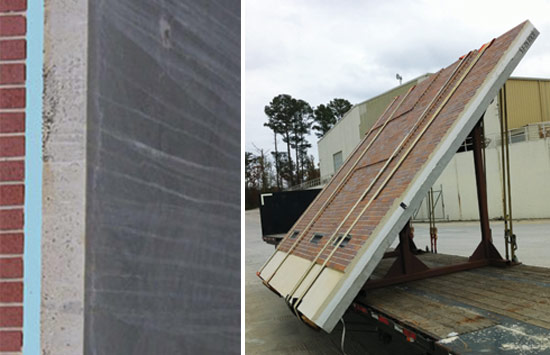 |
Precast sandwich wall panels, which contain twowythes of concrete that sandwich insulation, can provide the continuous insulation, air barrier, and vapor retarder in one efficient system. Image by PCI (left) ; Photo by Gate Precast Company (right) |
Barrier wall system. Precast concrete panels are considered air and watertight. A properly designed precast wall system is a “rain barrier” that provides better performance and requires less materials and trades than conventional cavity wall systems or rain screens. Concrete in general provides a relatively good vapor retarder, assuming it remains crack free—achieved by standard specifications for compressive strength, etc.—and that penetrations, joints and interfaces with other materials are properly detailed. Three inches of high strength concrete constitutes a code-compliant vapor retarder. Air entrainment is used to improve freezing and thawing resistance, particularly in severe environments.
Functional resilience. Expressing a building's ability to withstand and be quickly restored to its full functional capacity with minimal effort and resources after natural or man-made disasters, functional resilience expands the concepts of sustainability and durability. Functional resilience also helps minimize negative effects to the environment after such an event, since resilient structures do not need to be completely rebuilt. Precast concrete has a solid track record for ensuring the attributes of resiliency, including a long service life, durability, life safety, and wind and water resistance.
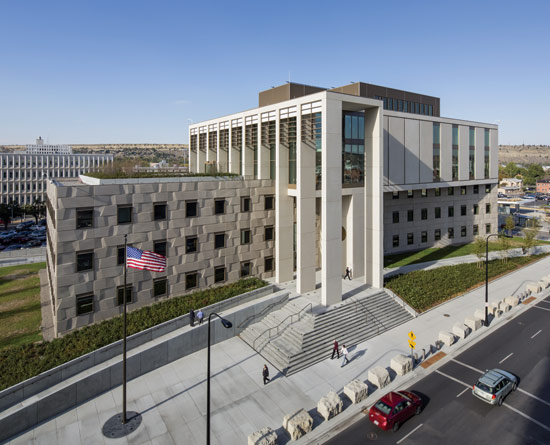 |
The James F. Battin Courthouse in Montana used a precast concrete solution to meet their high-performance requirements including anti-terrorism force protection design. Photo © Sean Airhart/NBBJ |
Multi-hazard protection. High-performance precast concrete wall panels are strong enough to withstand high winds and wind-driven projectiles, hurricanes, and wildfires. The high strengths and low water-cementitious ratios used in the precast manufacturing process, combined with proper compaction imbue the material with the capacity to withstand storms and render it resistant to wind-driven rain and moist, outdoor air in hot and humid climates. In short, concrete is impermeable to air infiltration and wind-driven rain. Architects should note, as with all envelope systems, joints between panels must be properly installed and maintained in order to provide a complete barrier system. Precast concrete walls should be allowed to breathe on at least one side and should not be covered by an impermeable material on both wall surfaces.
Research shows that appropriately designed precast concrete framing systems have a proven capacity to withstand major earthquakes, as demonstrated by recent earthquakes in Guam, United States (Richter scale 8.1); Manila, Philippines (Richter scale 7.2); and Kobe, Japan (Richter scale 6.9). These events subjected precast buildings to some of nature's deadliest forces.
Unlike seismic and wind loads, blast loads have an extremely short duration that can be measured in milliseconds. Often, the large mass associated with the overall building response provides enough inertia so the building's framing does not need to be strengthened to resist blast loads. While conventional foundation systems are almost always adequate to resist the short duration reaction loads from a building's response to blast loads, architectural precast concrete can be designed to mitigate the effects of an explosion and thereby satisfy requirements of the General Services Administration. In fact, extensive research on seismic and blast design with the Air Force Research Laboratory has generated increased use of precast concrete in seismic zones and military and government structures, which have antiterrorism force protection requirements.
• Life safety and health. A building's resilience is also dependent on systems that ensure indoor environmental quality and protection from fire and other disasters.
Indoor environmental quality. Volatile organic compounds (VOC) are environmental hazards that degrade indoor air quality when they off-gas from new products, such as manufactured wood items like laminate and particleboard. VOCs can also combine with other chemicals in the air to form ground-level ozone. Concrete contains low to negligible VOCs, far less than almost any other typical interior finish product.
Precast concrete surfaces are often used as durable interior finish. Polished concrete floors do not require carpeting. Exposed concrete walls do not require finishing materials, eliminating particulates from sanding drywall taping seams. Concrete is not damaged by moisture and does not provide nutrients for mold growth. Precast has low sound transmission classification and impact insulation class ratings, providing architects with inherent material qualities with which to meet increasingly more stringent indoor acoustical requirements.
The negligible level of VOCs in concrete construction can be further reduced by using low-VOC materials for form-release agents, curing compounds, damp-proofing materials, wall and floor coatings and primers, membranes, sealers, and water repellents. Precast concrete components also work to meet standards for indoor air quality because they are delivered to the site in modules that do not require fabrication, processing, or cutting at the construction site, thereby reducing dust and airborne contaminants on site.
Passive fire resistance. A total-precast concrete system provides an effective design for minimizing fire damage and containing the effects within the smallest space possible for the longest time. Concrete is noncombustible and can contain a fire within boundaries. As a separation wall, precast concrete helps prevent fire from spreading throughout a building or jumping from building to building. Noncombustible compartmentalization, combined with an inherently fire resistant/tolerant structural frame, provide the best combination of economics and protection that owners and users seek. When this passive design combines with other safety measures, including sprinklers and early-warning detection systems, a balanced fire protection design is achieved.
Disaster safety. Many schools and public facilities also serve as safe areas of community refuge during times of natural disasters, particularly those involving high winds such as tornadoes or hurricanes. Certified and approved precast concrete safe rooms and storm shelters have a role to play in providing secure areas for communities during severe weather, and comply with both FEMA 320 and FEMA 361, design criteria for residential and community safe rooms, respectively.
Case Study
| Dormitory at Catholic University Uses a Precast Sandwich Panel for Energy Efficiency | ||
|
The new eight-story, 127,000-square-foot dormitory on the Catholic University of America (CUA) campus, called Opus Hall, was developed by a design-build team that used precast concrete for thermal performance. The precast concrete envelope system was comprised of sandwich panels that include 3 inches of exterior concrete, embedded with thin brick, 2 inches of continuous insulation, and 5 inches of structural concrete with an exposed, steel-troweled interior finish, providing outstanding energy efficiency with material R-value of 14.25. By exposing the interior finish of the precast, the designers maximized the thermal mass benefits of the concrete. Preinsulated panels have edge-to-edge insulation and the layers of concrete are tied together with non-conductive connectors, eliminating thermal bridges. Effectiveness of the wall system was validated by a thermal imaging comparison of the completed project and nearby, masonry campus buildings. Carl Petchik, executive director of facilities operations for the university, estimates that it will cost CUA less to run the new building than it does to run both Millennium North and Millennium South residence halls. The project also features energy-efficient appliances and a high-performance HVAC system.
|
High-performance Envelopes—Strategies
By its very nature, precast concrete provides many high-performance attributes and, when precast concrete solutions are properly designed with effective building envelope strategies, designers can further enhance building performance.
Combination of Continuous Insulation, Air and Vapor Barriers in One System
With the advancement of energy codes, designers are approaching envelope design differently. Building envelopes in most regions of the United States must provide continuous insulation and a continuous air barrier. Envelopes also are required to provide a vapor barrier to control condensation and indoor humidity, as well as avoid compromising the insulation system. Precast concrete's edge-to-edge insulation, combined with the nonconductive connectors between the interior and exterior concrete layers, can create an efficient thermal break that prevents heat and moisture from penetrating the building and eliminates thermal loss and vapor transmissions present in other wall assemblies. With the addition of continuous insulation to precast concrete walls, which already provide an air and moisture barrier, this type of assembly effectively integrates the air, moisture, and heat management of the envelope into one efficient system.
Utilizing Concrete's Thermal Mass Potential
High-performance precast concrete sandwich wall construction is an efficient way to combine thermal mass and insulation in walls. To maximize the benefits of this, the interior side of precast concrete sandwich walls should be left exposed as the finished interior surface. Since precast concrete envelopes essentially have no thermal bridging, these attributes combined decrease indoor temperature fluctuations and enabling downsizing of HVAC systems and their associated first cost and long-term operational costs.
ASHRAE 90.1-2010 acknowledges the thermal mass benefits of concrete walls in specifying lower minimum insulation R-values and higher maximum wall U-factors for mass (concrete) wall construction in specific geographic areas. Essentially, the ASHRAE standard means that this type of assembly stores heat energy and registers better performance than the sum of its parts. That is, while the components of a wall individually add up to a material R-value, the mass wall performs at a much greater R-value—up to two times greater than that of the material itself. While the degree of improvement in R-value in a given structure is greatly dependent upon climate, occupancy type, building orientation, and other parameters, when used in the right combination, insulation and thermal mass, along with a building design that captures solar light and heat energy, can significantly improve thermal performance and lower energy requirements.
 |
The material R-value can be calculated by adding up the R-values of the materials that make up the assembly. In this example, the material R-value is R-11.65. However the actual performance R-value of this wall is greater due to thermal mass and no thermal bridging. Image by PCI |
Making the Interior Wythe the Finished Interior Wall
Precast sandwich wall construction can be designed to use the interior wythe of concrete as the finished interior wall. This strategy reduces the need for drywall and decreases mold potential while improving the project's ability to take advantage of the thermal mass benefits associated with precast concrete. A smooth steel trowelled interior concrete wall can be left bare or finished with direct-applied coverings, coatings, or paint (Note: these materials should not be vapor barriers, as to allow the concrete to breath) to minimize interior obstructions and fit-out costs. Both options provide a surface that will not be dented, punctured, corroded, rusted or otherwise damaged by heavy-duty use or equipment. Panels can be cleaned easily, even with harsh chemicals and steam pressure, ensuring a clean, crisp, hygienic environment. Vermin and insects cannot destroy concrete because it is inedible. With proper coordination and planning, conduit runs, as well as electric and other service boxes, can be incorporated into the precast panel during production.
Envelopes as Part of the Structural System
The most economical application of precast concrete wall units is as loadbearing structural-aesthetic components. Combining the insulated architectural façade with the structural system reduces the need for additional connections, and decreases the thermal bridges in an envelope system. It also reduces material, the number of trades required to construct the wall system and thus, general conditions. The loadbearing units become an integral part of the structure, transferring loads to the foundation, including gravity loads from the floors and roof and lateral forces from the effects of wind or seismic events, and providing for the horizontal stability of the building.
From a design perspective, the greatest advantage of a loadbearing precast concrete system is an interior that provides large open floor plates unencumbered by perimeter columns. Combining loadbearing wall panels with a precast structural floor system creates long, clear unobstructed spans with large, open bays with interior heights up to 55 feet. In most cases, the height is restricted only by what can be transported and delivered to the site. For offices, 45 to 50 foot spans are optimal because beyond that length, bays become so deep that daylighting is compromised. With early coordination, panels can be designed with electrical conduits and outlet boxes cast into the panel, eliminating additional interior furring and material, trade overlap problems, and the need for a separate wall cavity. Field labor costs are reduced, as installations can be completed simply by pulling the wires, installing fixtures, and covering the boxes.
 |
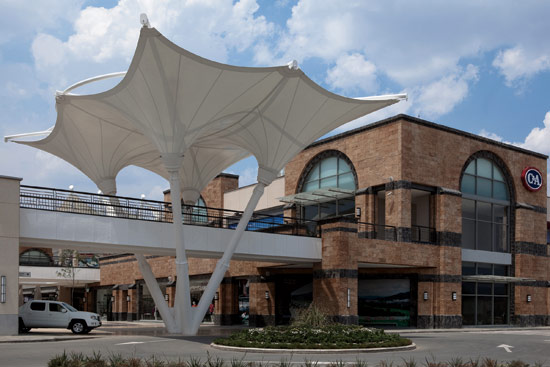 |
The Paseo Altozano in Mexico used a combination of chiseling, acid etching, and pigment treatments to achieve its unique finish. Photos © FOTOSENCONCRETO.COM |
High-Performance Aesthetics
Precast concrete has a wide aesthetic range that complements its high-performance attributes. Smooth as-cast finishes show the natural look of the concrete. Exposed-aggregate finishes, via chemical retarders and water washing, are achieved with a non-abrasive process that effectively brings out the full color, texture, and beauty of the coarse aggregate. Sand or abrasive blasting provides all three degrees of exposure noted above, and acid-etching dissolves the surface cement paste to reveal the matrix with only a small percentage of coarse aggregate being visible. In addition, concrete can be cast against liners made of wood, steel, plaster, elastomeric, plastic, or foam plastic to create numerous shapes and patterns or to replicate natural stone materials. Precasters can help design professionals understand how to achieve a wide range of color and texture variations in precast architectural panels within the project budget.
Precast Envelope Systems: Providing High Performance
High-performance buildings that satisfy a host of stringent demands are becoming the norm among today's owners. Precast concrete envelope systems inherently provide many of these high-performance attributes, and can be designed to provide many others. Precast sandwich panels provide an effective envelope that integrates and optimizes insulation levels, shading of glazing, solar reflectivity of exterior surfaces, air and vapor barriers, and thermal mass. When these attributes are combined with the strength, long-term durability, and multi-hazard protection inherent in the material itself, the result is a very high-performance building.
 |
PCI develops, maintains, and disseminates the Body of Knowledge for the precast/prestressed concrete structures industry. PCI provides technical resources, certification, and education, as well as conducts industry events, research and development, and more. www.pci.org |

